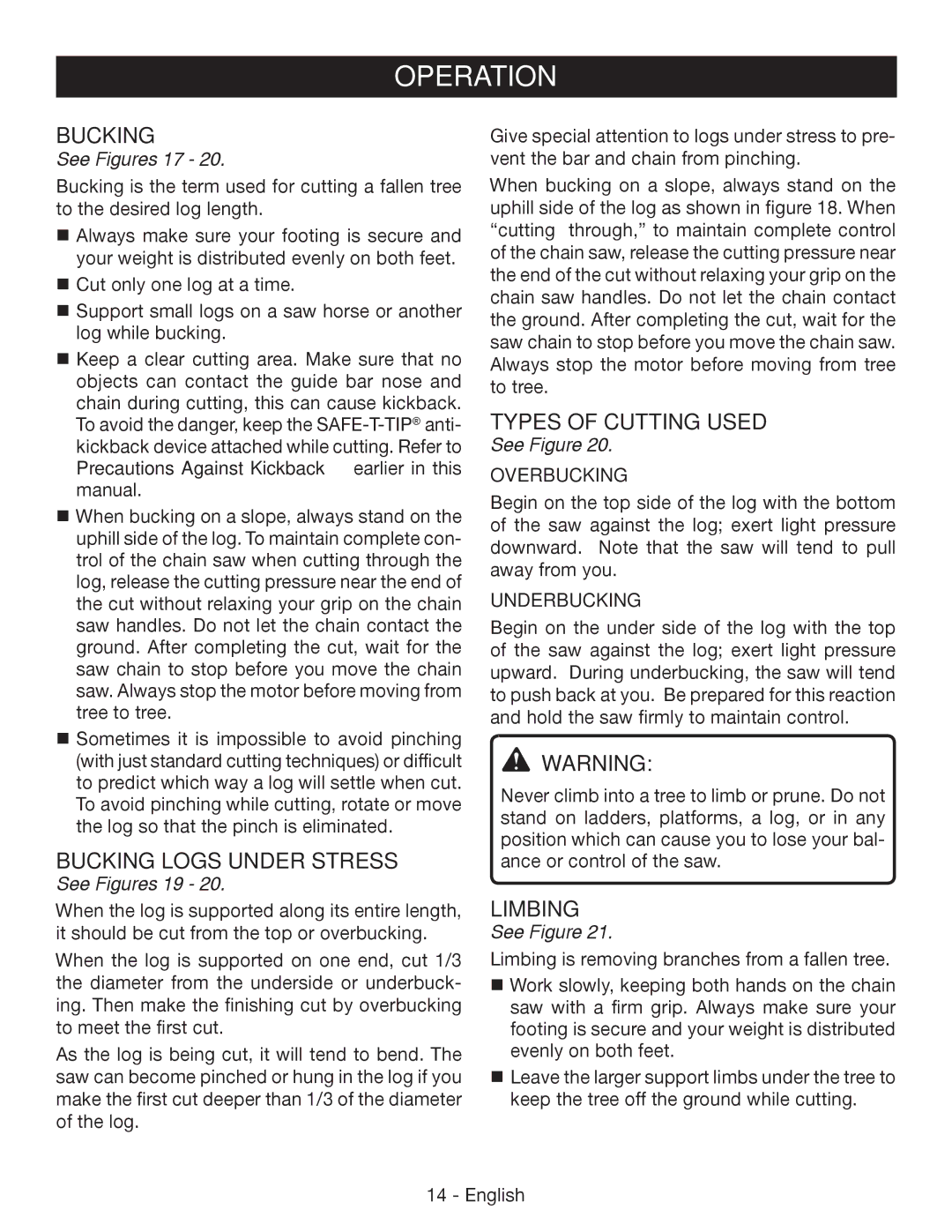
OPERATION
Bucking
See Figures 17 - 20.
Bucking is the term used for cutting a fallen tree to the desired log length.
Always make sure your footing is secure and your weight is distributed evenly on both feet.
Cut only one log at a time.
Support small logs on a saw horse or another log while bucking.
Keep a clear cutting area. Make sure that no objects can contact the guide bar nose and chain during cutting, this can cause kickback. To avoid the danger, keep the
When bucking on a slope, always stand on the uphill side of the log. To maintain complete con- trol of the chain saw when cutting through the log, release the cutting pressure near the end of the cut without relaxing your grip on the chain saw handles. Do not let the chain contact the ground. After completing the cut, wait for the saw chain to stop before you move the chain saw. Always stop the motor before moving from tree to tree.
Sometimes it is impossible to avoid pinching (with just standard cutting techniques) or difficult to predict which way a log will settle when cut. To avoid pinching while cutting, rotate or move the log so that the pinch is eliminated.
BUCKING Logs Under Stress
See Figures 19 - 20.
When the log is supported along its entire length, it should be cut from the top or overbucking.
When the log is supported on one end, cut 1/3 the diameter from the underside or underbuck- ing. Then make the finishing cut by overbucking to meet the first cut.
As the log is being cut, it will tend to bend. The saw can become pinched or hung in the log if you make the first cut deeper than 1/3 of the diameter of the log.
Give special attention to logs under stress to pre- vent the bar and chain from pinching.
When bucking on a slope, always stand on the uphill side of the log as shown in figure 18. When “cutting through,” to maintain complete control of the chain saw, release the cutting pressure near the end of the cut without relaxing your grip on the chain saw handles. Do not let the chain contact the ground. After completing the cut, wait for the saw chain to stop before you move the chain saw. Always stop the motor before moving from tree to tree.
Types of Cutting Used
See Figure 20.
Overbucking
Begin on the top side of the log with the bottom of the saw against the log; exert light pressure downward. Note that the saw will tend to pull away from you.
Underbucking
Begin on the under side of the log with the top of the saw against the log; exert light pressure upward. During underbucking, the saw will tend to push back at you. Be prepared for this reaction and hold the saw firmly to maintain control.
![]() WARNING:
WARNING:
Never climb into a tree to limb or prune. Do not stand on ladders, platforms, a log, or in any position which can cause you to lose your bal- ance or control of the saw.
Limbing
See Figure 21.
Limbing is removing branches from a fallen tree.
Work slowly, keeping both hands on the chain saw with a firm grip. Always make sure your footing is secure and your weight is distributed evenly on both feet.
Leave the larger support limbs under the tree to keep the tree off the ground while cutting.
14 - English
